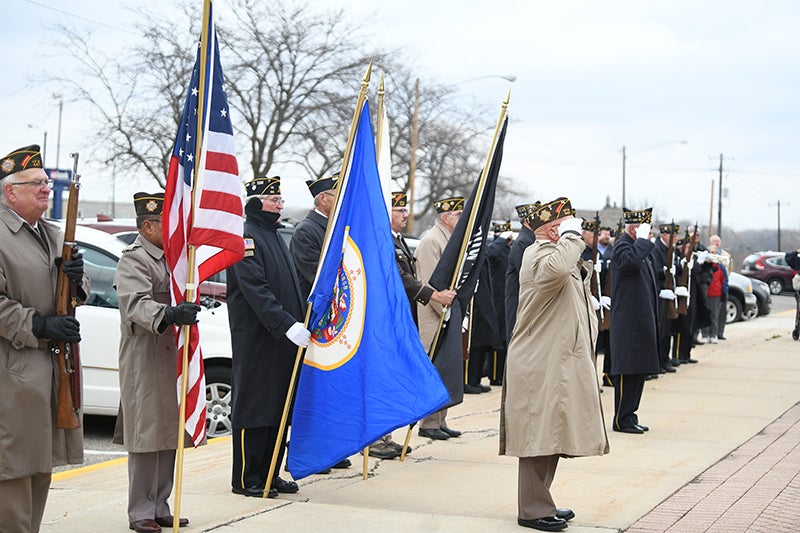Walz tours storm damage in Freeborn, Mower counties
Published 1:02 pm Saturday, April 13, 2019
AUSTIN — Minnesota Gov. Tim Walz learned about last week’s efforts to restore power to portions of southeast Minnesota during a visit to Mower and Freeborn counties Saturday morning.
Walz was briefed by members of emergency management, law enforcement and the National Guard on where things stood as Freeborn-Mower Cooperative Services, along with line workers from other places in Minnesota, Iowa, Wisconsin and Illinois, continued working on downed lines and returning power to communities.
Walz also toured the two-county region by air, where he got a visual of power poles laying on their sides and downed power lines.
“The one thing that’s important is to get up there and see it,” Walz continued. “If you’ve got power at your house, the snow is going to be melted, it appears nothing happened. This is pretty catastrophic. It was good to see it that way.”
One by one, communities in both counties have steadily come back online. Freeborn County Emergency Management Director Rich Hall reported that Clarks Grove got its power back at around 10:30 p.m. Friday night and Alden not long after at around 12:20 a.m. Saturday morning.
As of Monday morning, about 400 outages remained in the Freeborn-Mower Cooperative Services territory, and that number was reduced by 100 by Monday afternoon.
At the storm’s height, Freeborn-Mower Cooperative Services CEO Jim Krueger said 8,200 customers were without power and around 500 power poles were downed.
“This has been kind of unreal to watch unfold,” Krueger said.
State officials said it’s unclear just how much this disaster will cost in the end. As more and more power is returned and the cleanup comes to close, assessments of damage will become clearer with the hopes of getting federal dollars to bolster state emergency funding.
“I think people look at this and they didn’t see the buildings blowing down, we didn’t see the massive flooding, but this is a very expensive proposition to build this back up,” Walz said.
Walz in a letter to the White House on Monday informed President Donald Trump of the recent severe weather events in Minnesota and the looming need for federal disaster relief.
“Minnesotans are hardy people and we have a lot of experience taking care of each other during and after severe weather,” Walz wrote. “Over the past 12 months — not counting this event — Minnesota has experienced 10 major disasters.
“We believe the uninsured damage to public infrastructure and other costs for this event will far exceed our threshold for public assistance (PA) program disaster relief from the Federal Emergency Management Agency (FEMA),” he continued.
People coming together
From the beginning, last week’s storm had an instant impact.
Mower County Sheriff Steve Sandvik said his deputies were dealing with multiple crashes from the beginning and with the arrival of the ice and wind impact, the stress on resources became clear.
“We had every available deputy on the road,” Sandvik said. “We had no assets to maintain public service.”
In Freeborn County, Sheriff Kurt Freitag saw much of the same thing with his department as well as fire departments from surrounding communities.
“Before the (National Guard) was able to arrive, we had just about all of our fire departments out,” he said.
Crews from Freeborn-Mower Cooperative were out immediately to deal with the situation, but as conditions continued deteriorating, it became clear it was going to be an uphill climb.
“Our line guys really fought a losing battle that first day,” Krueger said.
The big boost came from the National Guard, which within 4 1/2 hours after Walz’s disaster declaration had troops out in the counties, blocking off roads that had power lines across them. This freed up the sheriff’s departments to get back to attending to their duties.
Overall, 143 soldiers from the National Guard were deployed and 48 vehicles utilized.
“They were superbly prepared because they knew this was their mission,” said Maj. Gen. Jon Jensen, adjutant general of the Minnesota National Guard. “It’s very reflective of how seriously we take this mission across the state.”
Walz praised the leadership and cooperation that has helped get things back to where they need to be.
“There’s a lot of leadership here, working at a lot of levels in here and that’s critical,” Walz said. “This is what we are supposed to do. We’ll do this right and will continue to monitor.”
Down the stretch
While plenty of work remains to be done, officials are seeing positive steps toward getting everybody back up and running again.
“There are poles still on the ground, but when the cities and townships are with power, then we’re well on our way to recovery,” said Mower County Emergency Management Coordinator Amy Lammey. “It’s going well.”
Likewise, Hall said he’s feeling good about where Freeborn County is currently standing.
“I think we’re pretty resilient,” he said. “The communities rallied together … recovery is long term, but we’re going to get there one step at a time.”









